|
|
 |
|
Gardening Blog
|
 |
|
|
Thursday, September 27, 2012
Speaking about Managing Pests in Veggie Gardens
I will be speaking on October 6th at the Dunedin Community Center about managing pests in vegetable
gardens at 12 noon. Below is the flier for this event - I would love to see you there.
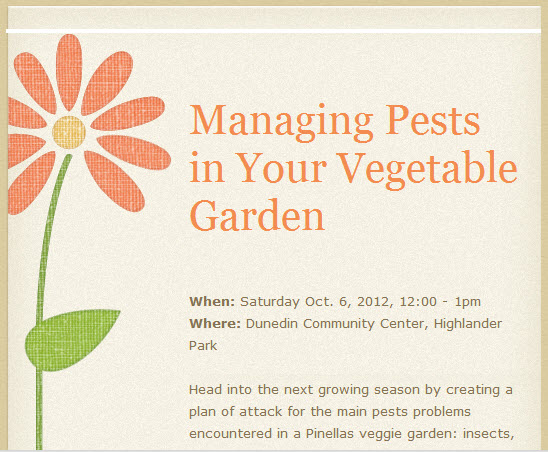
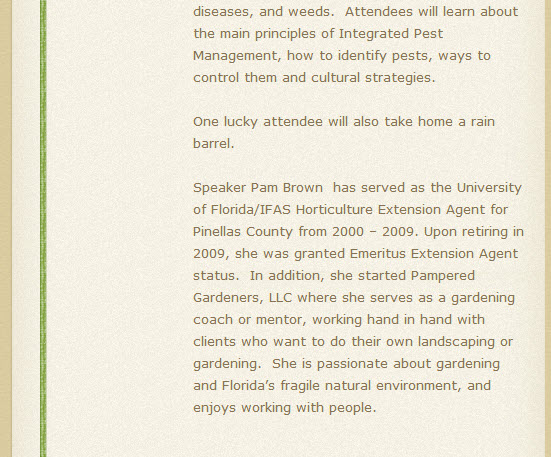
Monday, September 24, 2012
Laurel Wilt – new disease killing Redbay trees.
Laurel Wilt is a fungal disease carried into host trees
by the redbay ambrosia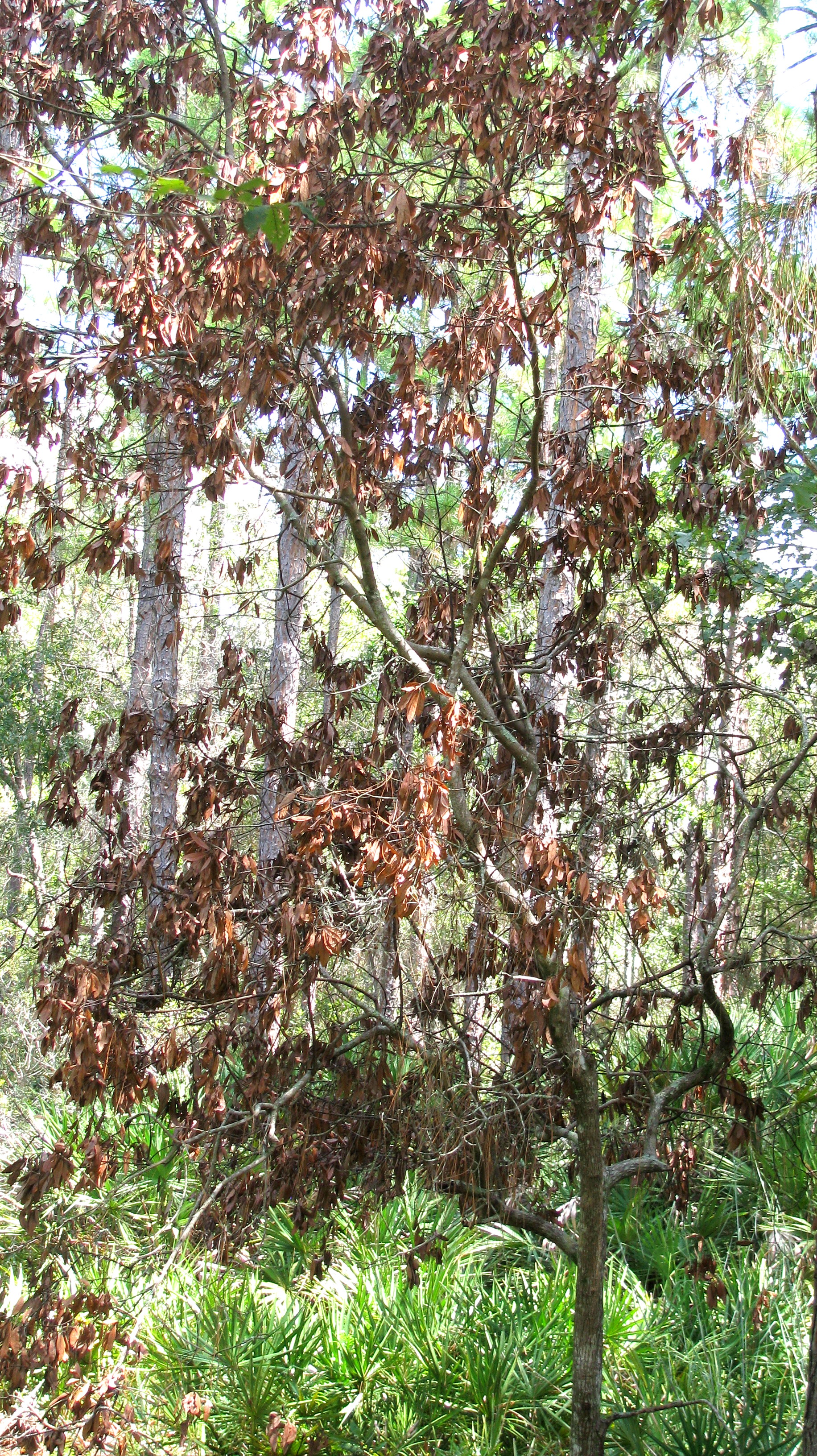 beetle. This is a disease of primarily redbay (Persea borbonia), avocado (Persea americana),
and other plants in the laurel (Lauraceae) family). The fungus is carried into the tree in the
mouthparts of the redbay ambrosia beetle (Xyleborus glabratus) as it bores into the tree. The
fungus grows inside the tree stopping the flow of water and nutrients in the vascular system. This causes
the leaves to wilt and the whole tree to eventually die. beetle. This is a disease of primarily redbay (Persea borbonia), avocado (Persea americana),
and other plants in the laurel (Lauraceae) family). The fungus is carried into the tree in the
mouthparts of the redbay ambrosia beetle (Xyleborus glabratus) as it bores into the tree. The
fungus grows inside the tree stopping the flow of water and nutrients in the vascular system. This causes
the leaves to wilt and the whole tree to eventually die.
In addition to the
trees mentioned above, reported hosts of the both the redbay ambrosia beetle and the laurel wilt fungus include swampbay (P.
palustris), and sassafras (Sassafras albidum). The laurel wilt fungus has also been 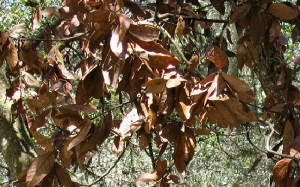 recovered from diseased plants of pondberry (Lindera melissifolia), camphor tree (Cinnamomum camphora),
and pondspice (Litsea aestivalis). recovered from diseased plants of pondberry (Lindera melissifolia), camphor tree (Cinnamomum camphora),
and pondspice (Litsea aestivalis).
This invasive beetle
was first detected in the United States in 2002 and Florida in 2005. There have already been devastating
levels of redbay tree death in Florida, Georgia, and South Carolina. In addition avocado trees have succumbed
to this disease in both residential and experimental settings.
This disease is now found in north Pinellas County in and around John Chestnut Park especially along the Peggy Park
Trail. It is also killing redbay trees in Brooker Creek Preserve. I can see a dead redbay
tree behind my house just inside the Preserve.
The Laurel Wilt fungus
causes the leaves of affected trees initially to droop and turn a reddish or purplish color. You might
see wilted foliage first only in part of the crown of the tree, but the whole crown will soon wilt. The
leaves will turn brown and hang on the tree for a long time. There is not as much experience with this disease in avocado, but it appears that avocado trees might drop their
leaves soon after wilting and turning brown.
Another symptom is
a black to brown discoloration of the sapwood in infected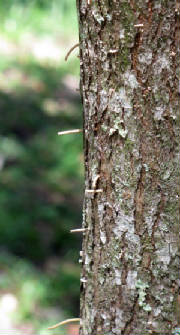 trees. By removing bark from wilted trees you will see this discoloration in streaks running parallel
to the grain of the wood. You might also see tubes of sawdust a couple of inches long hanging on the trunk
where the beetle has bored into the tree. trees. By removing bark from wilted trees you will see this discoloration in streaks running parallel
to the grain of the wood. You might also see tubes of sawdust a couple of inches long hanging on the trunk
where the beetle has bored into the tree.
Redbay is not a common landscape tree,
but many of us have an avocado tree in our yards. If you find that you have one of these dead or dying
trees in your landscape, it is important to remove it properly. This wood must not be moved from the area
to use as firewood in another location, especially to counties where this pathogen is not found. Chipping
the wood has been found to reduce the beetles since they cannot colonize chipped wood products. However,
this chipped wood must not be removed from the county of origin to use as mulch elsewhere since there is a possibility that
a few beetles could survive. This fungus has not been documented to spread by any means other than this
beetle, but as a precaution, it is good practice to sanitize any tools that you use to cut an infected tree.
For more extensive information for Homeowners about this pest form the
University of Florida, visit this site: http://trec.ifas.ufl.edu/RAB-LW-2/pdfs/homeowner%20recs%20RAB-LW%202-25-11.pdf
Monday, September 3, 2012
Coping with Deer Damage in the Landscape
I don’t think that there are
many things more frustrating in the landscape than coming outside in the morning and finding that newly installed plants have
been consumed or damaged by deer. We contend with this problem regularly here in North Pinellas County.
In the past I have written about plants that I call “deer candy”, but this month I will focus on plants
that I have used in my landscape that have not been damaged by deer in the twelve years I have lived right next to Brooker
Creek Nature Preserve.
I have found that many of the native plants are resistant to deer damage. The natives that I have
in my 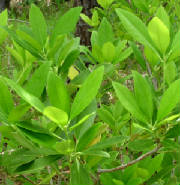 landscape that have not suffered damage are Dwarf Yaupon Holly and landscape that have not suffered damage are Dwarf Yaupon Holly and 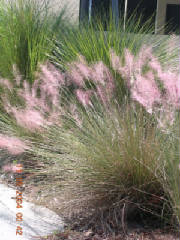 regular Yaupon Holly, Dwarf Simpson’s Stopper and regular Simpson’s Stopper, Dwarf Walter’s Viburnum (deer
do nip off the flowers occasionally), Beautyberry, Coontie, Yellow Anise, Saw Palmetto, Swamp Lily, Blue Flag Iris, Rain Lily,
Spider Lily, Gulf Muhly Grass, Firebush, and Sunshine Mimosa ground cover. Non-natives that have
not sustained deer damage include Sweet regular Yaupon Holly, Dwarf Simpson’s Stopper and regular Simpson’s Stopper, Dwarf Walter’s Viburnum (deer
do nip off the flowers occasionally), Beautyberry, Coontie, Yellow Anise, Saw Palmetto, Swamp Lily, Blue Flag Iris, Rain Lily,
Spider Lily, Gulf Muhly Grass, Firebush, and Sunshine Mimosa ground cover. Non-natives that have
not sustained deer damage include Sweet 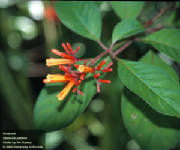 Viburnum, Ligustrum, ‘Gold Mound’ Duranta, Foxtail Fern, Bird of Paradise, Variegated Flax Lily, Holly Fern, Bromeliads,
Mondo Grass, Society Garlic, and Palms. Viburnum, Ligustrum, ‘Gold Mound’ Duranta, Foxtail Fern, Bird of Paradise, Variegated Flax Lily, Holly Fern, Bromeliads,
Mondo Grass, Society Garlic, and Palms.
My decision to use these plants was mainly trial and error. There
are lists of plants that deer damage and that are deer resistant. The University of Florida has one: Ornamental
plant susceptibility to damage by deer in Florida (http://edis.ifas.ufl.edu/pdffiles/UW/UW13700.pdf). However, deer will try new plants when they are
hungry and if they find them tasty, they will keep coming back to them. Ane, where deer densities are high, as
here in North Pinellas, even plants that are normally avoided can be eaten. Deer repellant sprays come in tow knids, smell based and taste
based. Both types work for a limited time, so you need about three different ones so that you can rotate what you use
each time you spray. If you are thinking about fencing, the fence needs to be
at least eight feet tall. Electirfied fences work too, but are not practical in a densely populated area like ours.
Fences that are solid that deer cannot see through are also effective.
I
believe that a better strategy is to just say 'no' to deer candy plants, choose resistant plants, don't replace damaged plants
with like kind, use mostly native plants and wildflowers, and lastly, be willing to share with them.
Plants Dangerous to Pets
Every once in a while I find an article
that I have written that needs repeating. If you have pets, this one could be of importance to you.
There are some plants that we use in our Florida landscapes that can
be deadly if consumed by pets; azaleas, cycads or sago palms, and oleanders. Others can make animals sick.
We are usually familiar with the Dieffenbachia or dumb cane dangers since they affect humans too. Chewing
on this plant can lead to suffocation because the Calcium Oxalate crystals in the plant tissues cause the throat to swell.
But, there are many more common plants that are used in the landscape and as house plants that can cause distress for
our pets.
Some of the common house plants are aloe, amaryllis, caladium, peace lily, calla lily, elephant ears,
philodendron, antherium, and pothos. Cats are particularly sensitive to lilies like amaryllis, daylily and crinum. Other plants
that we use in our landscapes that can be toxic include; dracaena, kalanchoe, hydrangea, lantana, yucca and iris.
Even tomato plants are toxic.
The Veterinary Pet Insurance Company’s list of top 10 list of plant poisoning claims
include fruits and plant parts. While raisins and grapes caused the most problems along with some other edibles, many of our
familiar plants are on the list.
· Number 4 is Lily - the
poisonous component for cats has apparently not been identified, even ingestions of very small amounts of a lily plant could
result in severe kidney damage.
· Number 7 is Sago Palm - All parts are
poisonous, but the seeds contain the largest danger. The ingestion of just one or two seeds can result in vomiting, diarrhea,
depression, seizures and liver failure.
· Number 9 is Azalea – ingestion of a few leaves
can result in serious effects
that typically occur within a few hours after ingestion, and can include acute digestive upset, excessive drooling, loss of
appetite, frequent bowel movements/diarrhea, colic, depression, weakness, loss of coordination, stupor, and leg paralysis
· Number 10 is Hydrangea – ingesting parts of this plant can result
in a gastrointestinal disturbance with vomiting,
depression, and diarrhea.
If you have pets and also have any of these problem plants, use common
sense. If your pet does not usually chew on plants, then it shouldn’t be a problem. If
you have a dog or cat that likes to dig, then Amaryllis, caladiums, and other bulbs may not be appropriate for your landscape
since they might dig them up and decide to chew on them. You could consider removing the toxic plants or
fencing the area off to the pet. Several of the plants I listed are also used as house plants and that
could create a problem. Sometimes animals, especially dogs, which are bored, will chew just for the fun
of it. If you choose to keep the plants, familiarize yourself with the symptoms that a pet may show if
they ingest one of these plants and seek help immediately if your pet shows any of these symptoms.
This list is not complete. If you are concerned
about any plants, do some research at the library or on the Internet. If you still have questions consult with your veterinarian.
The ASPCA web site has comprehensive searchable information about plants that are toxic or non-toxic
to pets: http://www.aspca.org/pet-care/poison-control/plants/.
|
|
To subscribe to this blog - click on XML icon.
|
 |
|
|
|
 |
|
|
Pampered Gardeners LLC * Oldsmar, FL * USA * Phone: 727 483-3783 * pam@pamperedgardeners.com
|
|
|
 |

